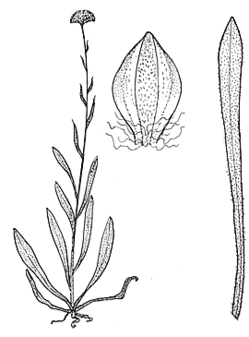Craspedia jamesii J.Everett & Joy Thomps. APNI* Synonyms: Craspedia sp. B sensu Jacobs & Pickard (1981) APNI*
Craspedia sp. H sensu Thompson (1981) APNI*

Description: Herb with a single scape 25–80 cm high; roots thick, spreading.
Leaves flaccid, mainly basal, spathulate, 3.5–20 cm long, 5–30 mm wide, apex acute to broad-acuminate, base usually long-attenuate, surfaces and margins evenly covered with multiseptate, or occasionally glandular hairs or glabrous, the tips glabrous; upper leaves lanceolate, stem clasping, 0.5–17 cm long, 2–20 mm wide.
Compound head ± flattened hemispherical 15–35 mm diam., with c. 25–125 partial heads; partial heads with 5–12 florets, main bract often 3-toothed, herbaceous, silky at base and occasionally hairy in the centre or on margins, lobes and margins scarious; scape cream to crimson, hairy. Corollas golden yellow.
Achenes 0.5–2.0 mm long; pappus of 14–24 plumose hairs 1.5–5.5 mm long.
Flowering: summer.
Distribution and occurrence: Widespread in grassland in lower subalpine areas; south from Brindabella Ra.
NSW subdivisions: ST
Other Australian states: Vic.
This species probably hybridizes with orange-flowered species.
Text by J. Everett & A. N. L. Doust
Taxon concept: Flora of NSW 3 (1992)
APNI* Provides a link to the Australian Plant Name Index (hosted by the Australian National Botanic Gardens) for comprehensive bibliographic data
***The AVH map option provides a detailed interactive Australia wide distribution map drawn from collections held by all major Australian herbaria participating in the Australian Virtual Herbarium project.
|


